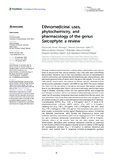| dc.description.abstract | Although medicinal plants have been used by ethnic communities since ancient
times to prevent and treat various diseases, only a few have been scientifically
documented. Therefore, due to their rare availability and lack of comprehensive
scientific information, we reviewed the ethnomedicinal uses, phytochemistry, and
pharmacological activities of plants within the genus Sarcophyte. To do this, we
used specific search terms and phrases to retrieve relevant information from
online sources published in English from 2000 to July 2023. The results showed
that there are only two plants in the genus Sarcophyte (Sarcophyte sanguinea
Sparrm. and Sarcophyte piriei Hutch.), which are traditionally used to treat a wide
range of diseases, especially cancer, and skin, gastrointestinal, and urinogenital
tract ailments in humans, and to cure animals in ethnoveterinary practices. It was
noted that 13 secondary metabolites have been isolated from the two plants, the
most prominent of which are flavonoids (diinsininol, diinsinin, and naringenin). The
antioxidant activity of S. piriei is reported based on the scavenging of 2,2-diphenyl-
1-picrylhydrazyl (DPPH) (IC50: 4.26 ± 0.22 μg/mL) and 2 -2′-Azino-di-[3-
ethylbenzthiazoline sulfonate (ABTS) radicals (IC50: 4.62 ± 0.14 μg/mL),
chelating iron (IC50: 1.82 ± 0.01 μg/mL, 3.50 ± 0.09 μg/mL), and nitric oxide
(IC50: 9.97 ± 0.88 μg/mL, 9.09 ± 0.11 μg/mL). The methanolic stem extracts of S.
piriei possess antimicrobial activity against Staphylococcus aureus, Escherichia
coli, Klebsiella pneumoniae, Vibrio fluvialis, and Enterococcus avium, with
minimum inhibitory concentration (MIC) values ranging from 0.16 to 0.625 mg/
mL, and a minimum bactericidal concentration (MBC) of 1.25 to 5 mg/mL.
Cytotoxic effects of the extracts from the two plant species were also
demonstrated. Sarcophyte piriei possesses therapeutic potential as evidenced
by the inhibitory effects of the aqueous rhizome extract on edema (1,000 mg/kg)
and prostaglandin synthesis (IC50 = 0.2 mg/mL). In addition, diinsininol and
diinsinin were isolated from S. sanguinea inhibited prostaglandin synthesis (IC50: 9.20 μM, 13.14 μM) and platelet-activating factor-induced exocytosis.
Therefore, based on this review, further scientific research is needed to
demystify the links between traditional medicinal uses, various secondary
metabolites, and the pharmacology of the two plants. | en_US |

